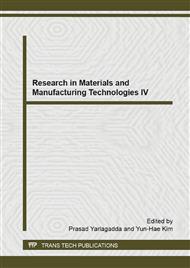[1]
H. Murase and R. Sakai, Moving object recognition in eigenspace representation: gait analysis and lip reading, Pattern Recognit. Lett., vol. 17, no. 2, p.155–162, (1996).
DOI: 10.1016/0167-8655(95)00109-3
Google Scholar
[2]
KORNPROBST P, DERICHE R, AUBERT G. Image sequence analysis via partial difference equations[ J] . Mathematical Imaging and Vision , 1999, 11 ( 1) : 5- 26.
Google Scholar
[3]
ELGAMMAL A, DURAISWAMI R, HARWOOD D, et al. Background and foreground modeling using nonparametric kernel density estimation for visual surveillance [ J] . Proceeding s of the IEEE, 2002, 90 ( 7) : 1151- 1163.
DOI: 10.1109/jproc.2002.801448
Google Scholar
[4]
STAUFFER C, GRIMSON WEL. Adaptive background mixture models for real-time tracking[ C] / /Proc of IEEE Conference on Computer Vision and Pattern Recognition. 1999: 246 - 252.
DOI: 10.1109/cvpr.1999.784637
Google Scholar
[5]
STAUFFER C, GRIMSON W E L. Learning patterns of activity using real-time tracking[ J] . IEEE Trans on Pattern Analysis and Machine Intelligence Ce, 2000, 22 ( 8) : 747 - 757.
DOI: 10.1109/34.868677
Google Scholar
[6]
MAGEE D. Tracking multiple vehicle using foreground, background and motion models [ J] . Image and Vision Computing, 2004, 22 ( 2) : 143- 155.
DOI: 10.1016/s0262-8856(03)00145-8
Google Scholar
[7]
J.M. Keller M.R. Gray and J.A. Givens, a fuzzy K-nearest Neighbor Algorithm , IEEE trans. syst. and Cybern., vol. SMC-15, 580-585, (1985).
DOI: 10.1109/tsmc.1985.6313426
Google Scholar
[8]
A Jordan - Advances in neural information processing systems, (2002).
Google Scholar
[9]
Bell, Anthony and Sejnowski, Terry. (1997) The Independent Components of Natural Scenes are EdgeFilters., Vision Research 37(23), 3327-3338.
DOI: 10.1016/s0042-6989(97)00121-1
Google Scholar
[10]
G. Welch and G. Bishop. An introduction to the Kalman filter. Technical Report TR 95-041, University of North Carolina, Department of Computer Science, (1995).
Google Scholar
[11]
Radeva, P., Serrat, J. and Mart´ı, E. (1995) A snake for model-based segmentation. In5th Int. Conf. on Computer Vision (ICCV'95), p.816–821, Cambridge, MA. IEEE.
Google Scholar
[12]
Zhiqiang Hou, Chongzhao Han. [ J] . ACTA Automatic sinica , 2006 , 32( 4) : 603- 617.
Google Scholar
[13]
I. Oikonomidis, N. Kyriazis, and A. Argyros. Markerless andefficient 26-DOF hand pose recovery. In Proceedings of the10th Asian conference on Computer vision-Volume Part III, pages 744–757. Springer, (2011).
DOI: 10.1007/978-3-642-19318-7_58
Google Scholar
[14]
I. Oikonomidis, N. Kyriazis, and A. Argyros. Markerless andefficient 26-DOF hand pose recovery. In Proceedings of the10th Asian conference on Computer vision-Volume Part III, pages 744–757. Springer, (2011).
DOI: 10.1007/978-3-642-19318-7_58
Google Scholar
[15]
Villaroman, N., Rowe, D., Swan, B. 2011. Teaching natural user interaction using OpenNI and the Microsoft Kinect Sensor. Proc. SIGITE 2011, 227-232. ACM.
DOI: 10.1145/2047594.2047654
Google Scholar


